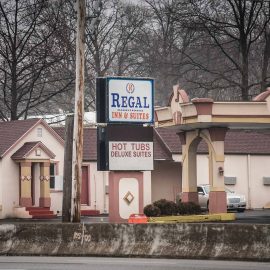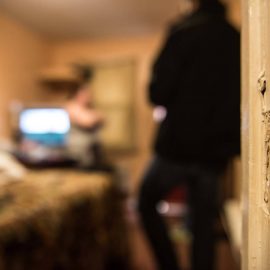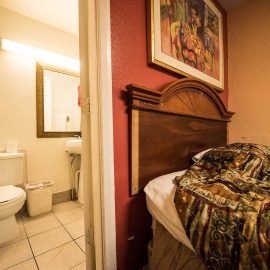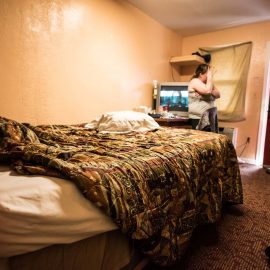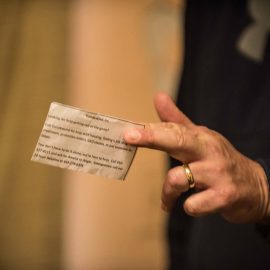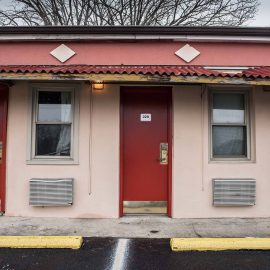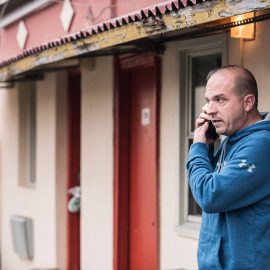News & Community
Children of the Night
Sex trafficking is Maryland’s dirty open secret.
It was not the first time “Wendy” had run away and not come home. The quiet 15-year-old from Prince William County, Virginia, chafed under the strict control of her single mom. She had lived previously in Maryland and had friends in Washington, D.C., who would help her get by for short periods.
Melvin Douglas approached her as a friend, too—a potential boyfriend even. She’d met him twice before, briefly, a few weeks earlier on the streets of D.C. The third time that the 31-year-old Douglas spotted her, they talked more. He offered to buy her a meal and a place to stay. He paid to get her nails and hair done, made her feel special, and told her that he cared about her.
Ten months later, in early 2012, Wendy’s photograph popped up on Cpl. Chris Heid’s computer. She was still missing. Heid had just begun working with the Maryland State Police’s Child Recovery Unit. “She looked like any schoolgirl,” he says of the image of Wendy distributed by the National Center for Missing & Exploited Children. He asked the Prince William Police Department if they minded if he looked into the case.
Digging through the girl’s old social media accounts, Heid came across a phone number on Facebook. It had been out-of-service for months, but running that number through Google he saw that it was associated with an outdated ad under “escorts” on Backpage.com—the Craigslist-like website of choice in the sex trade. Reaching out to administrators at Backpage (a notorious operation that has collaborated with police, at least in part, to protect itself from allegations of abetting prostitution and trafficking), Heid learned that the purchaser of that seven-month-old ad—who wasn’t Wendy—was linked to another, more recent Backpage ad, which was advertising a girl-for-hire in College Park.
Heid dialed the number and a young female voice answered. He asked if she had any time available. He asked how much a “short stay” cost. He asked where she was. At a hotel?
“She said, ‘Yes, College Park, near the school,’” Heid recalls. Presuming the young voice belonged to Wendy, Heid alerted the FBI task force and drove down there.
Heid called again when he got to College Park. The girl told him she was at the Quality Inn, as he’d guessed, and gave him her room number. With FBI agents hidden in position at the hotel, Heid, wearing a hoodie and jeans and sitting in an unmarked car, watched a man and another woman leave her room.
“I knocked and identified myself when I entered,” Heid recalls. “I told her I knew who she was and how old she was. She denied everything, including her real name. She’s like, ‘No, I’m not her. I’m not that girl.’
“But when I tell her the FBI has already grabbed the other girl and the guy, her entire demeanor shifted. She wasn’t scared anymore. She became polite. She became a kid again. She said she needed help; that she didn’t know how to get out.”
The grooming process had lasted about three months, Heid continues. “It’s always different, but it always lasts just until the exact moment the girl feels comfortable. Then it’s: ‘You gotta pay me back for all this. You owe me.’
“At first, she had thought she was his girlfriend. She had one tattoo—Melvin, the name of her pimp. He took all the money she earned. Later, he told her the only way she was getting out was in a body bag.”
That Heid was able to locate and recover a 15-year-old runaway and trafficking survivor so quickly is unusual. More unusual is that law enforcement officials elicited a guilty plea in federal court from Douglas. What is common in Maryland, however, is the sex trafficking of women and minors. In 2014, 396 survivors of human trafficking came in contact with the Maryland Human Trafficking Task Force. Of those, 381 were victims of sex trafficking, including 364 girls and women.
“We are talking about 14-, 15-, and 16-year-olds who are being sexually assaulted, raped, up to 20 times a day.”
In fact, the number of survivors identified by the state trafficking task force nearly doubled from 2013 to 2014, which doesn’t so much as indicate a skyrocketing number of victims as it does the degree to which the ongoing crisis has been hidden in plain sight. “The number of survivors coming in contact, in one way or another, with the victims’ services committee of the state human trafficking task force most likely is a fraction of the actual trafficking victims,” says Amelia Rubenstein, a researcher with the University of Maryland’s School of Social Work.
The data also reveal that those being sexually trafficked in Maryland are not who we might imagine.
The overwhelmingly majority of these survivors are not undocumented immigrants, for example. Nor are the majority chronic substance abusers. All but eight of the sex trafficking survivors in 2014 who came in contact with the state trafficking task force were U.S. citizens. Of those who reported their age, 56 percent were 17 or younger.
“Maryland is a hot spot of trafficking. It’s that simple,” says Maryland State Police Sgt. Deborah Flory, who oversees the agency’s two-person Child Recovery Unit. “That’s because of I-95, I-70, and BWI Airport, and the mix of wealth and poverty, which is one of the things that makes young women vulnerable.” Traffickers, aka pimps, are familiar with the laws in each state and know there are weaker penalties in Maryland than elsewhere, including the possibility of a misdemeanor charge for trafficking someone age 18 or older, Flory says. “We talk to them. They’re not dumb and they’re not worried. Some of them will wait until a girl turns 18,” Heid adds. “They can make more money than dealing drugs—$200,000 a year off of one girl—and it’s easier because they don’t have to re-up with cocaine or heroin. They sell the same ‘product’ over and over again.”
In 2016, Maryland ranked fourth among the top states per capita in trafficking cases, trailing Nevada, California, and Ohio, according to the National Human Trafficking Hotline.
Cpl. Chris Heid, an undercover officer with the Maryland State Police, leads a sting operation in Baltimore County looking for minors and women, such as this 20-something mother of two, who are being exploited by sex traffickers. Working with Sgt. Deborah Flory in the state police’s two-person Child Recovery Unit, Heid seeks to recover missing and underage victims and direct adult women to local resources, such as TurnAround, a local sexual assault/domestic violence with a trafficking survivors program. He and Flory also gather information related to traffickers, in hopes of making arresting and charging pimps.
On the one hand, a growing effort by advocates for survivors, including survivors themselves, to educate the public, law enforcement, and elected officials has started to bring attention to local human trafficking. On the other, little has been done to establish consistent human trafficking training for law enforcement agencies, or assist survivors.
Shockingly, there remains no established statewide protocol for handling juvenile survivors, who, to the incredulity of advocates, can still be criminally charged with prostitution in the state of Maryland.
“We are talking about 14-, 15-, and 16-year-olds who are being sexually assaulted, raped, up to 20 times a day,” says Amanda Rodriquez, a former Baltimore County prosecutor who now oversees the sex trafficking program at TurnAround, a nonprofit sexual assault/domestic violence intervention center with offices in Towson, Rosedale, and Baltimore City. More than half of the 200 to 225 trafficking survivors TurnAround sees each year are minors. The youngest person currently in their program is 11 years old. “In any other circumstance, a 50-year-old having sex with a 15-year-old would face statutory rape charges. Yet, in Maryland, we’re still holding the threat of incarceration over these girls.”
Rodriguez used to oversee human trafficking charges for the Baltimore County state’s attorney’s office, handling between 20 and 30 cases a year. It was her contact with victims of the traffickers who she was trying to lock up that eventually led to a career switch, working with survivors.
“It was a hard decision. I wasn’t looking to give up being an attorney and it’s important to go after the bad guys,” she says. One young woman in particular made a lasting impression—a 19-year-old single mother, struggling to keep herself and her son in their apartment. “I realized that could’ve been me or anyone else in her shoes,” Rodriguez says. “She was just vulnerable.” That young woman met the man who became her pimp at a bus stop, waiting for a ride home from work. He was filling up his silver Dodge Charger at a gas station across the street.
He saw her and walked over to introduce himself. To flirt. He told her that he had seen her looking at him while he was standing next to his car. She hadn’t been, but now that he was standing in front of her she did think he was cute. Looking across the street, she thought his car was cute, too.
He told her his name was Cartier, like the French jewelry company. Handsome, older, confident, he said he wanted to get to know her. She gave him her phone number and he texted her later. He asked if she had any pictures of herself and asked if she had any kids.
The cute guy with the cute car and the exotic name turned out to be 32-year-old Bennie Veasey. Not long after meeting “Tori,” he drove her and another woman from Ohio to the Sheraton Baltimore North hotel in Towson, coercing her to have sex with men and forcing her to hand over all the money.
Busted in a Baltimore County sting operation, Veasey was using the money to pay off lawyers’ fees stemming from a rape charge. He had also previously been indicted on rape, gun, and kidnapping charges involving a woman he’d met on an online dating chat line. “I spent a lot of time with the young woman who had the courage to testify against him,” Rodriguez says. “She had loved him and he had no regard for her. She talked about her dreams and her dreams for her son, and I got to know her as a human being.”
In some ways, Rodriguez’s career switch is representative of a change in focus that she and other advocates envision toward a public health approach that supports survivors of trafficking and prostitution. “A less shaming and a more survivor-centered paradigm,” says Rodriguez. “We’ve seen the shift in the approach to HIV, drug addiction. It’s more effective than incarceration.”
Although not every woman involved in the sex trade is trafficked, nearly every woman involved in prostitution was trafficked at one point or another. It’s worth keeping in mind that traffickers target not just teenagers, but children in their pre-teens. Children in foster care, children who have run away, and those who have been sexually abused previously are the most likely to be exploited.
In the U.S., an estimated 450,000 children run away each year. It’s also estimated that one in three of those teens will be lured toward prostitution within 48 hours of leaving home. Translated, that means that about 150,000 children are pulled into prostitution each year.
Twenty-seven-year-old Morgan State University student Withelma Ortiz Walker Pettigrew, who goes by “T,” grew up in Oakland, California, where she spent her first 18 years in the foster care system. For seven years, starting at age 10, she was victimized by sex traffickers on the street, in strip clubs, and in massage parlors. (Her story could’ve just as easily begun in Baltimore City, which produces the largest number of sex trafficking victims in the state by far. “I call Baltimore the Oakland of the East,” she says.)
Pettigrew spent her 17th birthday in a detention center, which she describes as another form of trauma. She also expresses frustration that she and her pimp, two individuals of color, were the targets of law enforcement and not the buyers, who were adults, primarily white, and would pay more for an underage girl.
She’s become a leading national advocate for survivors, testifying before Congress along with Cpl. Heid, offering ideas to improve the child-welfare system, pushing for victim assistance, and demanding that survivors help inform policies, training, and protocols going forward.
“First, there is an exodus of children from the Baltimore City child welfare system every year, including runaways [more than 3,000 overall in the city each year], and most people aren’t really concerned as long as they keep getting their checks,” Pettigrew says. “Poverty and homelessness are already an issue in the city and young people are easy prey. They end up getting pushed from one system into another—the juvenile justice system.”
Officials are quick to note that juveniles are rarely charged with prostitution anymore in the state. Minors do, however, end up in the juvenile system for other charges, often related to their victimization by trafficking. In 2012, four of Maryland’s seven juvenile detention centers began screening for victims of trafficking, and since then those detention centers have identified 103 trafficking survivors (97 girls and six boys). Those youths meet with behavior counseling staff, and depending on the nature of their offense, some may be diverted to a county social services department and linked with nonprofit providers and trauma-informed counselors. But there remains no specialized residential program in the state system for young trafficking survivors.
“At first, it’s hard to break the brainwashing that a survivor has experienced,” says Pettigrew, who spoke at a Johns Hopkins University human trafficking forum with Elizabeth Smart, a junior high school kidnapping victim in Utah several years ago. Part of recovery from brainwashing is severing the Stockholm Syndrome-like symptoms—victims often develop an attachment to their traffickers, and refuse to testify in court against their pimps. The other part, of course, is trying to rebuild—or build for the first time—self-esteem.
Smart told the Hopkins audience that she will never blame someone who doesn’t flee from traffickers or contact police because she knows how it feels to be scared and traumatized and to feel badly about yourself.
“She said you feel like a used piece of bubble gum that someone has discarded,” Pettigrew continues. “And who picks up a used piece of bubble gum off the ground?”
The most pressing legislative issue, Pettigrew says, is providing immunity to trafficked youths under 18. After that, advocates want to see the establishment of a statewide referral protocol, envisioning a single point of entry and the assignment of a case manager for trafficking survivors.
Beyond that there remains a range of steps Maryland could take to prevent trafficking and support survivors, including mandating consistent, survivor-informed awareness campaigns for schools and training for law enforcement. (The recent Department of Justice investigation into the Baltimore Police Department was scathing in regard to the department’s treatment of women making sexual assault complaints and alleged prostitutes.)
“. . . You feel like a used piece of bubble gum that someone has discarded. And who picks up a used piece of bubble gum off the street?”
University of Baltimore professor Jessica Emerson, who founded the school’s new Human Trafficking Prevention Project, works directly with survivors and women with prostitution convictions, trying to get their records expunged. She’s one of many advocates calling for stronger vacatur laws. “Right now women are required to get approval from the local State’s Attorney’s Office that prosecuted them before their convictions can be removed,” Emerson says. “There are just too many hoops to go through. These charges hinder efforts at finding housing and jobs, and can lead back to prostitution or other criminal activity.”
Her own criminal record, Pettigrew says, added hurdles to the college application process. She would like to see trafficking hotline numbers and awareness ads placed in more public spaces, such as bus stops and strip clubs, and pushed via social media.
Nearly all of these recommendations, in fact, were brought forth by the Maryland Safe Harbor Workgroup in its 2015 and 2016 reports. Montgomery County state Sen. Susan Lee, one of the workgroup members, has introduced several bills in the current General Assembly—including one that mandates awareness training for law enforcement—but she remains skeptical that substantial progress will be made in the 2017 session.
“I’ve been in meetings with legislators, my male colleagues, down in Annapolis, and some of them have told me there is no such thing as human trafficking,” says Lee, her voice shaking in disbelief. “They think all these girls and women just choose to do this. Or, they believe it is not a problem in their district—so, why create unnecessary laws?”
Lee added that at a recent hearing one survivor testified that she’d been confronted five times by local police while she was being trafficked and each time they treated her terribly. “She said the police were not on her side and she had no way of escaping her trafficker.”
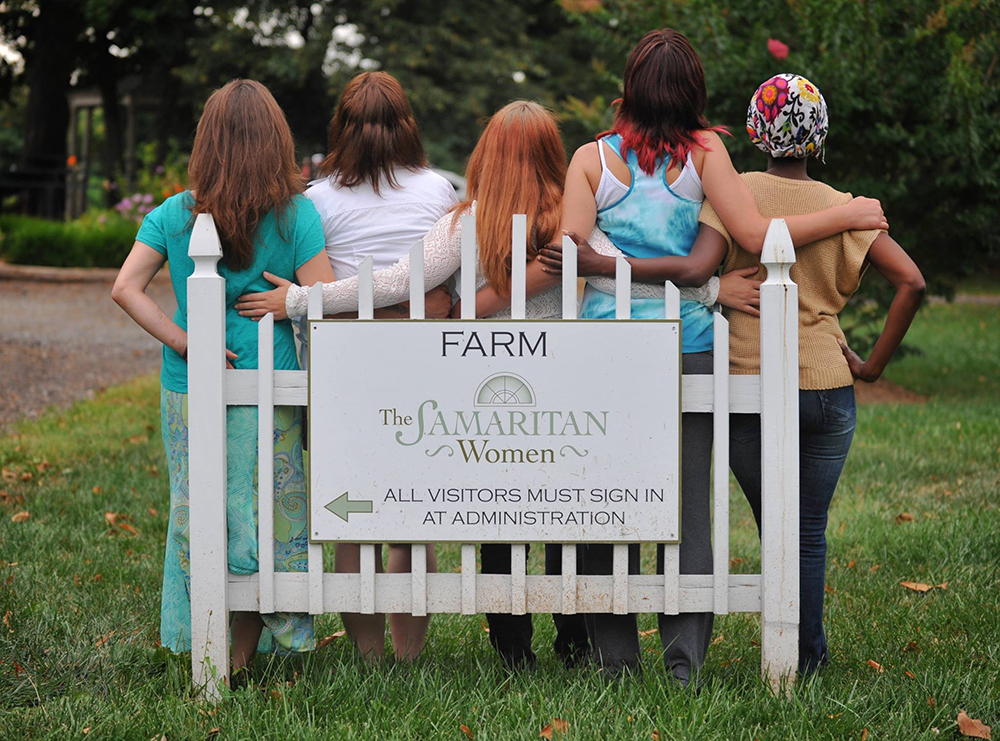
In the absence of successful state legislation and with Maryland ranking among the worst in terms of survivor assistance, according to a comprehensive 2014 study, several counties have tried to pick up the ball. Howard, Montgomery, and Prince George’s counties have each established their own human trafficking task forces. Howard County has also created its own asset forfeiture law aimed at establishing a victim’s assistance fund. Prince George’s County has passed legislation prohibiting hourly room rentals and requiring awareness training for motel and hotel employees. Prince George’s and Montgomery counties also now require licensing for massage parlors.
Baltimore City and Baltimore County state delegates and senators have not been leaders on the issue, according to local advocates. The Baltimore County Council has not created a specialized task force like other jurisdictions, nor has the Baltimore City Council.
In 2015, the Baltimore City Council did pass a law prohibiting hotels and motels from renting out sleeping accommodations for less than half a day and also requiring that city hotels and motels employees receive training on how to spot trafficking. But the deadline for completing that training passed in August 2016, and the Baltimore City Housing Department was unable to confirm at press time whether a single hotel or motel had complied.
On one potentially positive note, Gov. Larry Hogan has proposed legislation to close a loophole and further define child sexual abuse to include sex trafficking.
Jeanne Allert, founder and director of The Samaritan Women in Baltimore City, a private residential treatment center that receives survivors of sex trafficking from across the country, readily acknowledges that the issue is complex and that the problem can’t be fully addressed with one or two pieces of legislation, an executive order, or a single new policy.
But she says that should not prevent elected officials from learning the facts around trafficking and helping survivors get on their feet.
She also makes it clear that young women come to her program from every demographic. If an estimated 60 percent have been in the foster care system, it also means that 40 percent have not.
“We have girls whose parents are worth millions and bought them BMWs, and girls from abject poverty from Appalachia,” Allert says. “The commonality is that they all had something that made them vulnerable. Sexual abuse, alcohol or substance abuse in the home, which speaks to instability—these aren’t related to income. Every story is different. There is this myth of the perfect victim and there isn’t one when it comes to trafficking.”
Denene Yates, executive director of the Curtis Bay-based Safe House of Hope, which places exploited young women with private families, admits that this population of survivors isn’t exactly the easiest to work with. “These girls face a host of issues and complex traumas that take years to overcome,” she says. “We had a 15-year-old girl who stayed with us [Yates is married with children] and she said she had never sat down with family for dinner before.”
It’s not unlike the domestic violence issue and the way society used to—and still does, in many cases—blame women for not leaving, Allert says. “Well, these are often children and teenagers, and so you can imagine their decision-making process is even more affected. At a certain point, trafficking survivors believe that the person trafficking them was the only person who cared about them.”
Trafficking survivors need housing, therapy, education, and work force training, and they need to build self-esteem, Allert says. “They need to learn how to live as adults in the regular world,” she says.
“There are those who don’t think twice about these girls and who call prostitution ‘the world’s oldest profession,’” Allert says. “Other people call it what it really is, ‘the world’s oldest oppression.’”


